Bezaleel
Hazard to Others
  
Posts: 444
Registered: 28-2-2009
Member Is Offline
Mood: transitional
|
|
Iron(III) from Mohr's salt
Hi, I intended to oxidise Fe2+ to Fe3+ by dissolving 28.829g of Mohr's salt in water and adding 8.753g of sodium persulphate, Na2S2O8.
2Fe(2+) + S2O8(2-) => 2Fe(3+) + 2 SO4(2-)
My first surprise was that the solution of Mohr's salt turned yellowish when heated to around 40C (I added a drop of H2SO4 to make the solution
completely clear, pH became ~4):
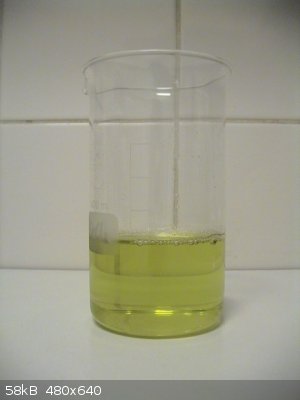
My second surprise was that adding the Na2S2O8 did not colour the solution yellow-brown, but it became some strange yellowish green (I understand
Na2S2O8 to be an oxidiser, not a reductor  ): ):
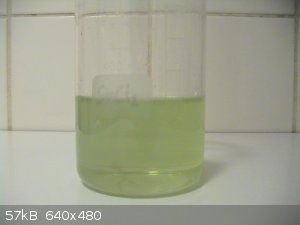
On heating the colour became more brownish. However, in comparison to a concentrated solution of NH4Fe(SO4)2, the solution is strikingly yellow and
pale (the pH dropped to 1 or less, and the solution has a slight smell of sulphur):
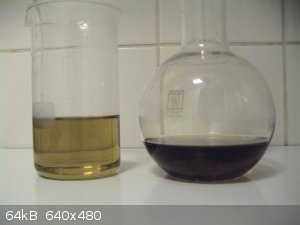 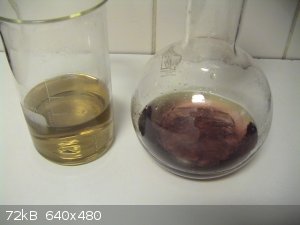
After cooling to ambient temperature, the difference is even bigger:
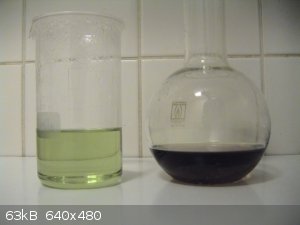 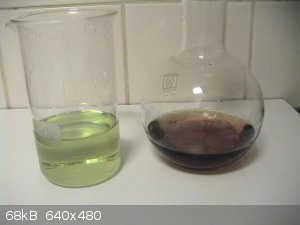
I feel like a fool to even ask this, but why is my solution yellow-greenish and not brown, like the Fe alum? Is there some reduction going on?
|
|
|
unionised
International Hazard
    
Posts: 5102
Registered: 1-11-2003
Location: UK
Member Is Offline
Mood: No Mood
|
|
Persulphate is (at least in some cases) a relatively slow oxidising agent. If you have any, a drop of silver nitrate solution may catalyse the
oxidation. (and after the reaction, you can remove the silver ions by adding a drop of HCl).
One of the reaction by-products is bisulphate which is quite strongly acidic.
The Fe(III) ion in acid solution is actually pale violet, but you need quite strongly acid conditions to see it.
The yellow colour you often see is due to hydrolysis.
|
|
|
woelen
Super Administrator
        
Posts: 7976
Registered: 20-8-2005
Location: Netherlands
Member Is Offline
Mood: interested
|
|
Smell of sulphur? You mean sulphur dioxide?
Are you sure that your sodium peroxodisulfate (Na2S2O8) is not sodium metabisulfite (Na2S2O5) or sodium thiosulfate (Na2S2O3)?
Indeed, peroxodisulfate is a sluggish oxidizer, but there definitely should not be any sulfurous odour.
Btw, I also find the color of the right solution not at all like the color of the iron(III) ammonium salt. The solution is very dark and it almost
looks purple/brown. Is this purple/brown solution just your NH4Fe(S)4)2? Or is it a mix of NH4Fe(SO4)2 with said Na2S2O8?
If you mix an iron(III) salt with thiosulfate, then you get an intensely colored purple/brown complex, which slowly fades over time, due to an
internal redox reaction in the thiosulfato-complex of iron(III).
[Edited on 1-2-21 by woelen]
|
|
|
Bezaleel
Hazard to Others
  
Posts: 444
Registered: 28-2-2009
Member Is Offline
Mood: transitional
|
|
Thanks, unionised. After standing over night, the solution is even more greenish than yesterday night, so apparently the oxidation is indeed
inhibited. I don't have any silver nitrate, but I can make some. I'll report back later.
I did find the bisulphate side reaction, so that I understand (and measure). But at the same time, if you say that Fe(III) is pale violet in strongly
acid solution (like the crystals of the alum), then how acid does it need to be to see this? It's 1 or less already. And at that pH, why is there
still hydrolysis causing the colour to become yellow and apparently mask the pale violet?
|
|
|
Bezaleel
Hazard to Others
  
Posts: 444
Registered: 28-2-2009
Member Is Offline
Mood: transitional
|
|
Woelen, I double even triple checked whether I used the right compound. According to the label it is and I used it successfully earlier. But It's a
good point, let me check for tests for peroxodisulphate (called persulphate by me).
The right solution is the NH4Fe(SO4)2, without Na2S2O8. The Na2S2O8 is only in the beaker on the left. The flask on the right also contains large
pale violet crystals, characteristic of the iron(III)alum. The content is over 30 years old, but has not changed over time.
|
|
|
woelen
Super Administrator
        
Posts: 7976
Registered: 20-8-2005
Location: Netherlands
Member Is Offline
Mood: interested
|
|
A simple test for peroxodisulfate is to prepare a dilute solution of AgNO3 in dilute HNO3. Add a few crystals of peroxodisulfate to this solution. If
the solution turns dark brown, then you have peroxodisulfate. This is a very specific reaction for the combination of silver(I) and peroxodisulfate
ion. The monopersulfate ion (SO5(2-)) does not show this reaction, nor does H2O2.
|
|
|
Bezaleel
Hazard to Others
  
Posts: 444
Registered: 28-2-2009
Member Is Offline
Mood: transitional
|
|
Thanks! I looked up Brauer but could not find any specific reactions, which he sometimes mentions in the compound description. So now I've got 2
reasons to make AgNO3.
|
|
|
woelen
Super Administrator
        
Posts: 7976
Registered: 20-8-2005
Location: Netherlands
Member Is Offline
Mood: interested
|
|
Distinguishing between peroxodisulfate and the other compounds I mentioned, however, is easily done with iodide. Just dissolve some KI or NaI in a few
drops of water and add a small pinch of the peroxodisulfate. Gently heat to make the solution warm (50 to 60 C). If you have peroxodisulfate, then the
liquid turns dark brown, with the other salts you might get at most a pale yellow color, or things remain completely colorless.
|
|
|
Bezaleel
Hazard to Others
  
Posts: 444
Registered: 28-2-2009
Member Is Offline
Mood: transitional
|
|
So I got the following after dissolving a few crystals of KI in cold water (~12C) and adding a comparable volume of my Na2S2O8:
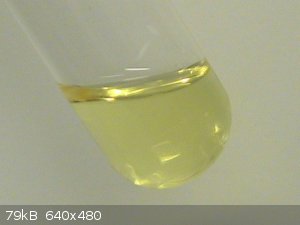
After heating up to where my fingers could not hold the tube any longer it still was only a little brown:
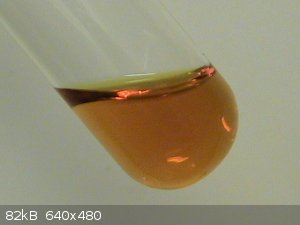
I let it cool and added a few drops of H2O2 of unknown concentration and the colour turned much darker. On heating some gas (oxygen) started to evolve
en the colour became like this:
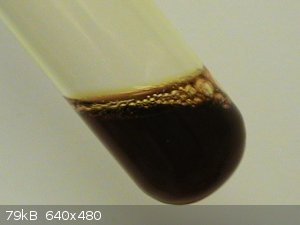
Moreover, the pH of the solution is 1 or less. I'm afraid that the oxidiser has died.
Since my peroxydisulphate seems to have converted to bisulphate, I think I may continu oxidation of my Mohr's salt solution by adding H2O2 solution.
Would it harm if I add an excess of H2O2 in this case? In other words, could a Fenton type of solution attack the NH4+ ions in it?
|
|
|
Bedlasky
International Hazard
    
Posts: 1219
Registered: 15-4-2019
Location: Period 5, group 6
Member Is Offline
Mood: Volatile
|
|
I once made ferric ammonium sulfate from old ferrous sulfate, battery acid and H2O2. And you need hugh excess of H2O2 and you need very good mixing.
H2O2 quickly decompose in concentrated solutions of ferric salts. It is possible to use it, but you must add it slow, in small portions and dilute
(not 30%).
|
|
|
woelen
Super Administrator
        
Posts: 7976
Registered: 20-8-2005
Location: Netherlands
Member Is Offline
Mood: interested
|
|
Weird. I have Na2S2O8, more than 15 years old and it still is as good as when I purchased it. I know of storage issues of (NH4)2S2O8 (that indeed
decomposes and loses its oxidizing power in a few years, and hence I do not buy that anymore), but the sodium salt and potassium salt both are stable,
even after years of storage.
|
|
|
Bedlasky
International Hazard
    
Posts: 1219
Registered: 15-4-2019
Location: Period 5, group 6
Member Is Offline
Mood: Volatile
|
|
Quote: Originally posted by woelen  | | Weird. I have Na2S2O8, more than 15 years old and it still is as good as when I purchased it. I know of storage issues of (NH4)2S2O8 (that indeed
decomposes and loses its oxidizing power in a few years, and hence I do not buy that anymore), but the sodium salt and potassium salt both are stable,
even after years of storage. |
I have K2S2O8 which is more than 30 years old. And it didn't lose its oxidizing power.
|
|
|
nitro-genes
International Hazard
    
Posts: 1048
Registered: 5-4-2005
Member Is Offline
|
|
If only oxidation to Fe(III) is required....
Reaction with oxygen from air can do the work when ligands are present that can keep the Fe(III) from hydrolysing, even at more basic pH which allows
Fe(II) to Fe(III) oxidation by oxygen itself. Addition of reasonably OTC ligands as ammonium citrate or triethanolamine, should do the trick. The
latter apparently is also interesting for electrodeposition of magnetite. https://www.researchgate.net/publication/277972506_Electrode...
And magnetite might be interesting as a cathode material itself for various reasons.  doi: 10.2134/jeq2003.1306 doi: 10.2134/jeq2003.1306
The addition of ascorbic acid to a solution of ferric ammonium citrate also seems interesting, producing some mauve (dirty purple) coloured complex
containing Fe(II) or mix of Fe(II) and Fe(III) that is probably unknown.
[Edited on 5-2-2021 by nitro-genes]
|
|
|
Bezaleel
Hazard to Others
  
Posts: 444
Registered: 28-2-2009
Member Is Offline
Mood: transitional
|
|
Quote: Originally posted by Bedlasky  | Quote: Originally posted by woelen  | | Weird. I have Na2S2O8, more than 15 years old and it still is as good as when I purchased it. I know of storage issues of (NH4)2S2O8 (that indeed
decomposes and loses its oxidizing power in a few years, and hence I do not buy that anymore), but the sodium salt and potassium salt both are stable,
even after years of storage. |
I have K2S2O8 which is more than 30 years old. And it didn't lose its oxidizing power. |
I tested my substance labeled Na2S2O8 by melting it. Only minor oxygen evolution took place. It melted below 100C, and stayed partly liquid when the
test tube had become hand warm. Not really what I would expect if it were reasonably pure Na2S2O8. Also a solution of the substance is strongly acid.
My guess is that something must have gone wrong in the manufacturing process. Industrially, it is made by electrolysis of NaHSO4 and it is as if this
wasn't brought to completion.
Indeed, all my google searches also stated that alkali-S2O8 is known for having an excellent shelf life.
Quote: Originally posted by Bedlasky  | | I once made ferric ammonium sulfate from old ferrous sulfate, battery acid and H2O2. And you need hugh excess of H2O2 and you need very good mixing.
H2O2 quickly decompose in concentrated solutions of ferric salts. It is possible to use it, but you must add it slow, in small portions and dilute
(not 30%). |
Thanks. I have a solution which is between 10 and 15%. I added small portions and as you said, a
lot of oxygen evolved, but the solution turned orange and then brown immediately. Indeed good stirring and slow addition are necessary. It's hard to
determine the point where all Fe(II) has been oxidised by this method, so I'll just add enough to be sure.
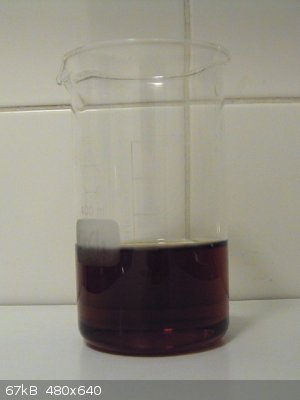
Quote: Originally posted by nitro-genes  | If only oxidation to Fe(III) is required....
Reaction with oxygen from air can do the work when ligands are present that can keep the Fe(III) from hydrolysing, even at more basic pH which allows
Fe(II) to Fe(III) oxidation by oxygen itself. Addition of reasonably OTC ligands as ammonium citrate or triethanolamine, should do the trick. The
latter apparently is also interesting for electrodeposition of magnetite. https://www.researchgate.net/publication/277972506_Electrode...
And magnetite might be interesting as a cathode material itself for various reasons.  doi: 10.2134/jeq2003.1306 doi: 10.2134/jeq2003.1306
The addition of ascorbic acid to a solution of ferric ammonium citrate also seems interesting, producing some mauve (dirty purple) coloured complex
containing Fe(II) or mix of Fe(II) and Fe(III) that is probably unknown.
[Edited on 5-2-2021 by nitro-genes] |
I chose the H2O2 method, but thanks for the suggestions. The mauve citrate complex appears interesting. I do have some iron citrate, so I'll test it
if I can find some ascorbic.
|
|
|
Bedlasky
International Hazard
    
Posts: 1219
Registered: 15-4-2019
Location: Period 5, group 6
Member Is Offline
Mood: Volatile
|
|
Bazaleel: I have some crystal remainder from this solution (I made crystal of this compound) and there is still some ferrous salt on violet crystals.
Btw. I think that you have NaHSO4.H2O which melts around 58°C.
Nitro-genes: That reaction between ammonium ferric citrate and ascorbic acid looks interesting.
|
|
|
Bezaleel
Hazard to Others
  
Posts: 444
Registered: 28-2-2009
Member Is Offline
Mood: transitional
|
|
Quote: Originally posted by Bedlasky  | Bazaleel: I have some crystal remainder from this solution (I made crystal of this compound) and there is still some ferrous salt on violet crystals.
Btw. I think that you have NaHSO4.H2O which melts around 58°C.
Nitro-genes: That reaction between ammonium ferric citrate and ascorbic acid looks interesting. |
Thanks. That is also good news, because it implies that the ferric salt crystallises before the ferrous salt and that they crystallise separately.
And yes, I think it is largely sodium bisuphate hydrate, based on the pH of its solution and its melting behaviour.
|
|
|
Bedlasky
International Hazard
    
Posts: 1219
Registered: 15-4-2019
Location: Period 5, group 6
Member Is Offline
Mood: Volatile
|
|
Ferric ammonium sulfate is far more soluble than ferrous ammonium sulfate. I firstly made ferrous ammonium sulfate, crystalized some out and rest I
oxidized in to ferric salt. Rest of ferrous salt crystallized at the end because there was just a small amount of it.
|
|
|